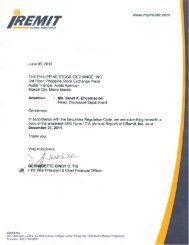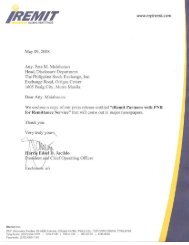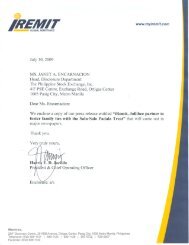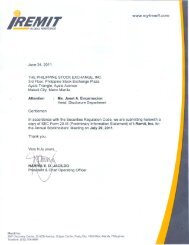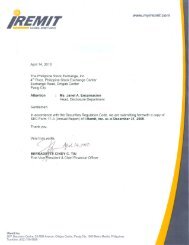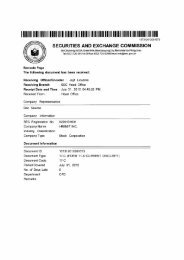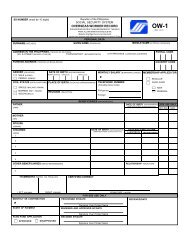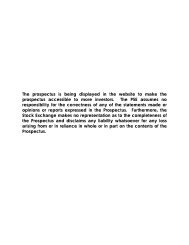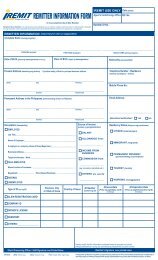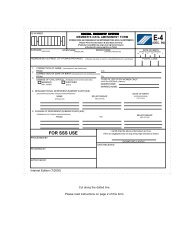SEC Form 20-IS - iRemit Global Remittance
SEC Form 20-IS - iRemit Global Remittance
SEC Form 20-IS - iRemit Global Remittance
You also want an ePaper? Increase the reach of your titles
YUMPU automatically turns print PDFs into web optimized ePapers that Google loves.
Classified under this category are the Group’s HFT investments in debt and equity<br />
securities.<br />
Loans and Receivables<br />
Loans and receivables are non-derivative financial assets with fixed or determinable<br />
payments that are not quoted in an active market. After initial measurement, receivables<br />
are carried at amortized cost using the effective interest method less any allowance for<br />
credit losses. Amortized cost is calculated by taking into account any discount or<br />
premium on acquisition and fees and costs that are an integral part of the effective<br />
interest rate (EIR). Gains and losses are recognized in the consolidated statement of<br />
income when the receivables are derecognized or impaired, as well as through the<br />
amortization process. Receivables are classified as current assets when the Group<br />
expects to realize or collect the asset within twelve months from the balance sheet date.<br />
Otherwise, these are classified as non-current assets.<br />
Classified under this category are the Group’s ‘Cash and cash equivalents’, ‘Accounts<br />
receivable’, ‘Other receivables’ and refundable deposits included under ‘Other<br />
noncurrent assets’.<br />
Other financial liabilities<br />
Issued financial instruments or their components, which are not designated as at FVPL,<br />
are classified as other financial liability, where the substance of the contractual<br />
arrangement results in the Group having an obligation either to deliver cash or another<br />
financial asset to the holder, or to satisfy the obligation other than by the exchange of a<br />
fixed amount of cash or another financial asset for a fixed number of its own equity<br />
shares. These include liabilities arising from operations or borrowings. The components<br />
of issued financial instruments that contain both liability and equity elements are<br />
accounted for separately, with the equity component being assigned the residual amount<br />
after deducting from the instrument as a whole the amount separately determined as the<br />
fair value of the liability component on the date of issue.<br />
After initial measurement, other financial liabilities are subsequently measured at<br />
amortized cost using the EIR method.<br />
Other financial liabilities are classified as current liabilities when the Group expects to<br />
settle the liability within twelve months from the balance sheet date. Otherwise, these<br />
are classified as noncurrent liabilities.<br />
Other financial liabilities include ‘Beneficiaries and other payables’ and ‘Interest-bearing<br />
loans’.<br />
Determination of fair value<br />
The fair value for financial instruments traded in active markets at the balance sheet date<br />
is based on their quoted market prices or dealer price quotations (bid price for long<br />
positions and ask price for short positions), without any deduction for transaction costs.<br />
When current bid and ask prices are not available, the price of the most recent<br />
transaction provides evidence of the current fair value as long as there has not been a<br />
significant change in economic circumstances since the time of the transaction.<br />
For all other financial instruments not listed in an active market, the fair value is<br />
determined by using appropriate valuation methodologies. Valuation methodologies<br />
include net present value techniques, comparison to similar instruments for which market<br />
observable prices exist, option pricing models, and other relevant valuation models.<br />
19



